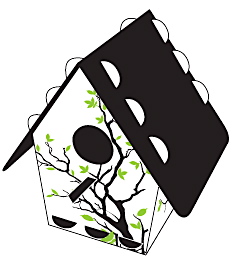-
Bluebird Houses in the News: Proven Beneficial
It’s difficult to convince folks sometimes, and all the blogging in the world may not make a bit of difference. But when the Associated Press does an article on the benefits of backyard birding…it seems a bit more substantial. Bluebird houses have been proven beneficial in the fight against unwanted insects. Much better than ineffective pesticides, most of which have been rendered useless….read on!
DEAN FOSDICK
This Jan. 23, 2005 photo shows an Eastern bluebird photographed near McLeansville, N.C. Eastern bluebirds are voracious insect feeders, especially during nesting and rearing periods. Their primary diet includes flies, katydids, beetles, worms and spiders. They’re aerialists, catching insects on the fly or pouncing on them on the ground. (AP Photo/Dean Fosdick)
Growers are beginning to understand that common birds can be of uncommon value to fields, lawns and gardens.
Many avian species earn their keep by eating insects and small mammals, and destroying weed seeds.
“Commercial growers are turning to birds as an alternative or supplement to pesticides,” said Marion Murray, an Integrated Pest Management project leader with Utah State University Cooperative Extension. “But you have to have the environment or habitat before inviting them in.”
That means mimicking nature by providing plenty of food, water and cover. Put up some bluebird boxes or nest boxes for raptors, said Marne Titchenell, a wildlife specialist with Ohio State University Extension.
“Monitor the bluebird boxes so sparrows don’t take over,” she said. “Brushier habitat provides protection for insect-eating songbirds. Allow the edges of your woodlot to grow up a bit. Berry-producing shrubs are excellent things to have around for all kinds of wildlife.”
Birds occupy a unique place in nature, according to the authors of a timeless 1912 study, “Red Bird, Green Bird: How Birds Help Us Grow Healthy Gardens,” by Harry A. Gossard and Scott G. Harry (Ohio State University Extension, revised edition 2009). “Each species performs a service which no other can so well accomplish,” the authors said.
Raptors such as hawks and owls chase down field mice, moles and grasshoppers. Insectivores like bluebirds, chickadees and woodpeckers stalk beetles, worms and grubs.
Meadowlarks are ground feeders, favoring meadows and farm fields where they gorge on grasshoppers and weevils. Robins focus on lawns and gardens, where they pull up cutworms, wireworms and other larvae injurious to crops.
Chickadees are birds of the forest, eating tent caterpillars, bark beetles and plant lice. Goldfinches prefer open country where they can pursue caterpillars and flies. “No other bird destroys so many thistle seeds,” the authors say.
“An individual tree swallow, barn swallow, purple martin or chimney swift can eat up to a thousand flying insects a day,” said David Bonter, assistant director of Citizen Science with the Cornell Lab of Ornithology. “They can have a big impact.”
While it’s great to have these specialized bug hunters around if you’re a grain farmer, small commercial farmer or orchard grower, recruiting should be directed toward a variety of species, said Margaret Brittingham, a professor of wildlife resources at Penn State University.
“All insect eaters feed at different heights, on different plants and prefer different insects,” she said. “Having some (bird) diversity is important in maintaining insect populations. What we don’t want to wind up with is having a monoculture with birds as we frequently do with plants, inviting problems.”
___
Online:
For more about birds for alternative pest management, see this Utah State University fact sheet http://utahpests.usu.edu/htm/utah-pests-news/fall-09/
You can contact Dean Fosdick at deanfosdick(at)netscape.net
-
Entice Birds With Nesting Materials
Most folks start with birdhouses and bird feeders to attract wild birds, and this is the perfect way to explore the great hobby of backyard birding. There are many other ways to increase the number of visitors and the number of species to your yard. Water is the number one element. Many birds who never visit a feeder will frequent a yard that offers a continuous fresh water source like a bird bath. Especially during frigid winters when water sources tend to freeze and become scarce, birds depend on a known spot for fresh water. Our bluebirds even over-wintered here in North Georgia, largely because of the three heated bird baths in the yard. Oh yes, the live mealworms helped too!
Many desired songbirds birds (like cardinals and finches) are not cavity-dwellers either, meaning they’ll never use a birdhouse.
Which brings us to yet another feathered friend favorite. Nesting materials are extremely important to birds in early spring. With a severe shortage in natural habitats, many depend on bird-friendly yards for their residence. There are all kinds of kits which offer refills too. This nesting material wreath is one, complete with feathers, cotton fibers, hemp, and raffia. The Bird Nester is a large, cage-like holder for cotton fiber nesting material, and offers refills as well. Even the Hummer Helper, which is nesting material designed specifically for hummingbirds offers refills.
Offering wild birds nesting materials in your yard really helps them to thrive and flourish. You can even craft your own materials using dryer lint, pet hair, cotton yarns, and mosses used in decorative floral design. Use a standard suet cage for holding the materials, or a mesh produce bag from the grocery store (like the kind apples come in). Late winter to very early spring is the best time to set them outside for birds. Simply hang from a tree branch, where they’ll be easily spotted, or even from one of the arms on your shepherd’s hook……happy birding!
-
Some Really Groovy Birdhouse Kits
Cavity dwelling birds face a very sad real estate problem…good homes are not so easy to come by these days. Mostly because of the vast destruction of natural habitat giving way to strip malls, schools, and more subdivisions. But also from the competition of non-native species. Just who brought over those House Sparrows anyway?
An educational and fun way to provide real nest sites for your feathered friends is with birdhouse kits. The standard wooden kits are widely availabl
e, even as bird feeders and bat house kits. Mostly crafted of durable cedar, they’ll provide many seasons of use and enjoyment. Lately, recycled plastics are the new craze in wild bird accessories, and they’re awesome as far as durability. Most are guaranteed to never crack, split or fade, plus they help to keep these plastics out of landfills. No worries of squirrels gnawing on them like traditional wooden bird accessories.
These recycled birdhouse kits have a unique design that’s fun to assemble, for little kids and big kids too. The groovy designs and vibrant colors are just plain fun, and best of all they provide great nesting sites, as well as roosting spots for wild birds. Th
e 1.25″ entrance is perfect for many small to medium-sized birds, and the perch is removable. These recycled plastic birdhouse kits add a splash of color in the yard, and will look great for years too.


 This Jan. 23, 2005 photo shows an Eastern bluebird photographed near McLeansville, N.C. Eastern bluebirds are voracious insect feeders, especially during nesting and rearing periods. Their primary diet includes flies, katydids, beetles, worms and spiders. They’re aerialists, catching insects on the fly or pouncing on them on the ground. (AP Photo/Dean Fosdick)
This Jan. 23, 2005 photo shows an Eastern bluebird photographed near McLeansville, N.C. Eastern bluebirds are voracious insect feeders, especially during nesting and rearing periods. Their primary diet includes flies, katydids, beetles, worms and spiders. They’re aerialists, catching insects on the fly or pouncing on them on the ground. (AP Photo/Dean Fosdick)



